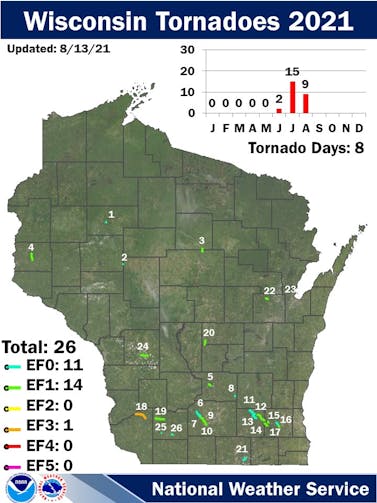Places around the world are experiencing abnormal and unprecedented weather events due to the rising climate crisis. In the last month, Wisconsin has seen some of these impacts in the form of major storms and tornadoes.
According to the National Weather Service (NWS), Wisconsin saw 24 tornadoes in the 15 day period from July 28 through Aug. 11 this year. On July 29, a string of storms occurred that included 10 tornadoes which developed in the Dane, Jefferson and Waukesha Counties. Straight-line, damaging winds that exceed 50-60 miles per hour were another element of these storms.
The tornadoes are in line with the belief that Tornado Alley is shifting across the country. According to a study by Victor Gensini, a meteorology professor at Northern Illinois University, and Harold Brooks, a member of NOAA’s National Severe Storms Laboratory, the expected area for this type of weather is moving from the central and southern Great Plains to the Midwest and Southeast.
A Milwaukee Journal Sentinal article reports updates from last week’s storms, explaining that 225,000 utility customers lost power on Aug. 10. According to the article We Energies, a power company serving Wisconsin and Michigan’s Upper Peninsula, believes the damage caused by the storms requires a “major rebuild” of the area’s electrical network.

Almost 100,000 utility customers spent Aug. 11 without power as temperatures stayed in the 80’s and 90’s in affected areas. Many cooling centers were opened in these areas to keep those who were left without air conditioning safe in the heat.
The evening of Aug. 11 also included troublesome weather, making it the sixth straight day of severe thunderstorms in the southern part of the state. A twister touched down in Dodgeville early in the evening and was followed by a tornado warning for Iowa and Dane County. The storm ended before it reached Dane County, but included two weak tornadoes, both with maximum winds of 60 miles per hour and classified as EF-0 in Iowa County.
These stormy conditions are more striking considering the other changes Wisconsin’s climate is going through. According to a Wisconsin Public Radio (WPR) article, “Wisconsin is already warmer and wetter than it was more than half a century ago.”
Temperatures have risen about 2 degrees in the last seventy years and are expected to warm between 2.5 and 7.5 degrees by 2050. On top of this, the state has experienced a 15% increase in the amount of rain and snowfall we have seen each year.
“The projections do suggest or show that we expect more of these heavy rainfall events, as well as longer dry spells in between,” said Dan Vimont, director of the Nelson Institute Center for Climatic Research and co-director of the Wisconsin Initiative on Climate Change Impacts. “Another thing that projections suggest is that warmer conditions will be associated with drier soil moisture and more ecological and agricultural drought.”
Rising temperatures are expected to accompany these precipitation conditions. The WPR article states, “In the summer, the number of days hotter than 90 degrees is likely to triple in Wisconsin. Under higher emissions scenarios, southern Wisconsin could experience three months of extremely hot days by the end of the century.”
In the nearer future, southern Wisconsin should expect more stormy weather at the end of this week. While there are no expectations for major storms this weekend, Wisconsin continued to experience tornadoes into September of 2019 and 2020 and October of 2019.
These weather conditions are not over for the year, even if the power is back on.
state news writer






